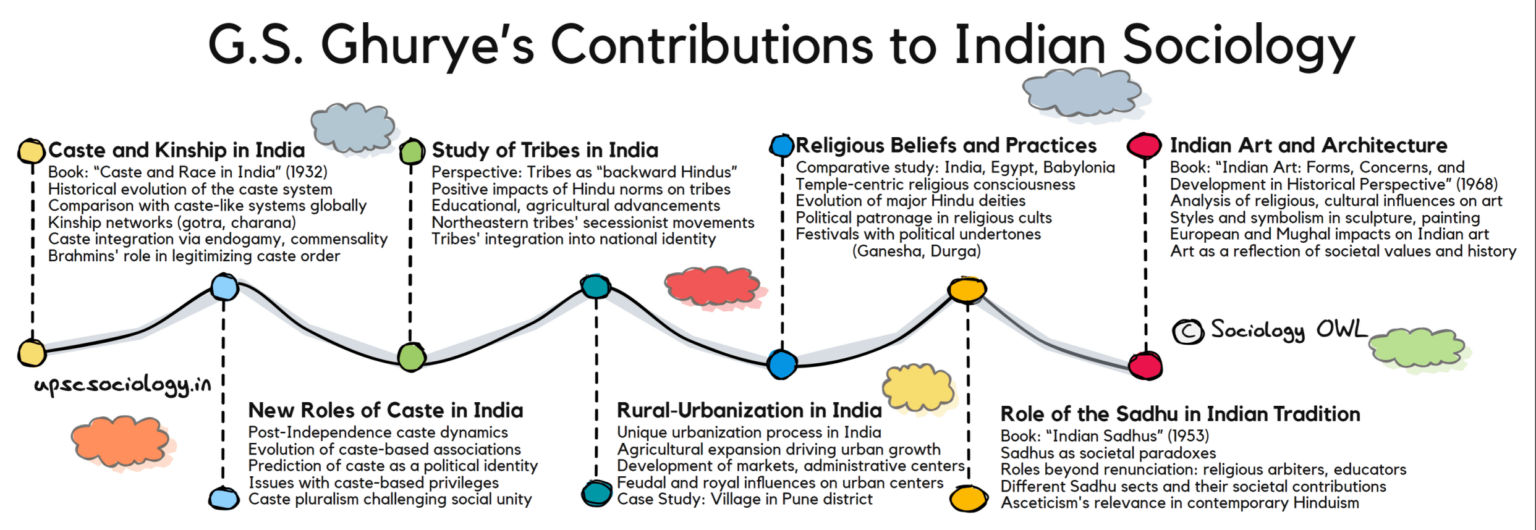Sociology Notes
G.S. Ghurye's Contributions to Indian Sociology
G.S. Ghurye’s Contributions to Indian Sociology
G.S. Ghurye, a prominent sociologist in India, made significant contributions to the field of Indian sociology. His work focused on various aspects of Indian society, including the ethnography of castes and tribes, rural-urbanization, religious phenomena, social tensions, and Indian art. This article will discuss Ghurye’s ideas in these areas, highlighting his major works and key findings.
Caste and Kinship in India
Ghurye’s book “Caste and Race in India” (1932) is still considered an important source on Indian castes. In this work, he examined the caste system from historical, comparative, and integrative perspectives. Ghurye emphasized two main points: the kin and caste networks in India had parallels in other countries, and kinship and caste served as an integrative framework in Indian society. He highlighted the importance of gotra and charana, which were kin-categories derived from the names of past sages. These categories systematized the rank and status of people in Indian society. Ghurye also discussed the role of endogamy and commensality in organizing castes into a collectivity based on norms of purity and pollution. He argued that Hindu religion provided the conceptual and ritualistic guidelines for this integration, with Brahmins playing a key role in legitimizing caste ranks and orders through their interpretation of sacred codes.
New Roles of Caste in India
Ghurye’s work on caste also explored its evolving roles in Indian society. He noted that Indian castes fostered voluntary associations for education and reformist aims, and predicted that these associations would give rise to a political consciousness based on caste ties. In post-Independent India, caste associations have indeed become vocal about seeking political concessions for their members. Ghurye also discussed the struggles of backward classes for better privileges, which he believed were undermining the unity of Indian society. He argued that the scramble for privileges among castes was damaging social cohesion and turning the caste system into a pluralistic competition.
Study of Tribes in India
Ghurye’s works on tribes in India focused on their historical, administrative, and social dimensions. He viewed Indian tribes as “backward Hindus” who were imperfectly integrated into Hindu society. Ghurye argued that the incorporation of Hindu values and norms into tribal life was a positive development, as it led to the tribes giving up liquor-drinking, receiving education, and improving their agriculture. However, he also documented secessionist trends among northeastern tribes and warned that these could damage the political unity of the country.
Rural-Urbanization in India
Ghurye was interested in the process of rural-urbanization and argued that it was not solely a result of industrial growth in India. He highlighted the indigenous sources of urbanism in India, where the growth of urban centers started from within rural areas themselves. Ghurye explained how the expansion of agriculture led to the need for markets in rural hinterlands, which in turn led to the development of townships with administrative and judicial institutions. He also discussed the role of feudal patronage and demand from royal courts in the growth of urban centers in the past. Ghurye’s study of a village in Pune district highlighted the continuity of social structure and the survival of villages as viable units.
Religious Beliefs and Practices in India
Ghurye made original contributions to the study of Indian religious beliefs and practices. He argued that the religious consciousness in ancient India, Egypt, and Babylonia centered around temples, and there were similarities between Indian and Egyptian patterns of worship and temple architecture. Ghurye traced the rise of major deities in Indian religion, such as Shiva, Vishnu, and Durga, to the need for integrating local or sub-regional beliefs into a macro-level system of worship. He also discussed the role of political patronage in the spread of popular cults in India and how religious festivals like the Ganesha festival and Durga festival retained political overtones even in the twentieth century.
Role of the Sadhu in Indian Tradition
In his work “Indian Sadhus” (1953), Ghurye examined the paradoxical nature of renunciation in India. He discussed the role of Sadhus or Sannyasins in Hindu society, who were supposed to be detached from caste norms and social conventions. Ghurye highlighted that while Sadhus were considered outside the pale of society, they played significant roles as arbiters of religious disputes, patrons of learning, and defenders of religion. He explored different groups of Sadhus, such as Shaivite Dashnamis and Vaishnavite Bairagis, and their contributions to Hindu society. Ghurye argued that asceticism was not a relic of the past but a vital aspect of current Hindu practices, with well-known ascetics like Vivekananda, Dayanand Saraswati, and Sri Aurobindo working for the betterment of Hinduism.
Indian Art and Architecture
In his book “Indian Art: Forms, Concerns, and Development in Historical Perspective” (1968), Ghurye explored the various forms of Indian art and architecture. He discussed the origins and development of Indian art, highlighting the influence of religion, culture, and historical events on artistic expressions. Ghurye examined different art forms such as sculpture, painting, architecture, and decorative arts, and analyzed their stylistic features, symbolism, and social significance. He also discussed the impact of foreign influences on Indian art, such as the Mughal and European influences, and how they shaped artistic traditions in India.
Ghurye’s work on Indian art and architecture aimed to provide a comprehensive understanding of the artistic heritage of India and its cultural and social context. He emphasized the interconnectedness of art, religion, and society, and how artistic expressions reflected the beliefs, values, and aspirations of the Indian people.
Overall, G.S. Ghurye made significant contributions to the field of Indian sociology, particularly in the areas of caste, tribes, rural-urbanization, religion, and art. His works continue to be influential in the study of Indian society and culture, providing valuable insights into the complexities and dynamics of Indian social life.
Download our app for UPSC Sociology Optional - Syllabus, NCERT Books, IGNOU Books, Past Paper with Model Answers, Topper Notes & Answer Sheet.

